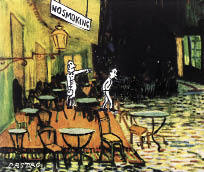No question about it, the world is becoming increasingly homogenised — not only, indeed not so much, in big things such as democracy and free trade as in small.
No question about it, the world is becoming increasingly homogenised — not only, indeed not so much, in big things such as democracy and free trade as in small. No snippet of news illustrates this more clearly than the ban on smoking in public places introduced last month in Syria. A few years ago, it seemed exotically health-conscious to legislate against the cigarette in Britain, let alone in nations across the Channel traditionally addicted to café society and dangling Gauloises. Now clearly it is only a matter of time before al-Qa’eda start putting up ‘Smoke Free Zone’ notices around their training camps in the wastes of Waziristan.
In Damascus, which we visited a matter of days before the new law came into force, this is going to have quite an impact. In local restaurants, it was still common to observe diners puffing away on a nargile (or hubble-bubble pipe) not just after a meal, but actually while they were eating. Mind you, such customs alter rapidly. When I was at university, a certain professor was noted for smoking between courses at college feasts, sometimes before other diners had finished their food. She was fond of a cigar.
Syria abounds in wonderfully preserved ancient ruins and crumbly Ottoman cities — but is doubtless not such a good place for opponents of the regime. The more sinister activities of the government internally and externally, however, don’t deter travellers. Though scarcely crowded with tourists, it is not unvisited either. We twice bumped into one group of British friends, meeting them again on the last day at the airport check-in queue.
They too had had an excellent time, only slightly blighted by having had a guide who had offered a running commentary throughout their trip: ‘On the left please notice another pile of stones.’ In contrast, our driver, Mr Ahmed, was limited in English to the question ‘Finish now?’ This, though disconcerting at first, was a blessing. Guides are the human equivalent of those taped explanations of exhibitions that burble in your ears and prevent peaceful concentration.
In Syria most stages of human civilisation still coexist. There are luxury hotels, traffic jams, airports and air-conditioning. But simultaneously nomadic Bedouin still herd their rangy flocks. An especially favoured spot for grazing, it turns out, is the central reservation of motorways. There, quite often, shepherds in Biblical robes are to be seen while their sheep feed on the rich roadside grasses. How they get the animals across the traffic, however, is a mystery — and a skill Abraham and Isaac didn’t require.
One day we visited Qalaat Semaan, the spectacular ruins of a 5th-century church built around the pillar on which St Simeon Stylites (c. 390-459) lived for 38 years. He was a glutton for discomfort, having begun as a young monk with voluntary austerities such as spending the summer buried in the earth up to his chin. Eventually, to escape the crowds of pilgrims attracted by his behaviour (who clustered around demanding miracles) he left his monastery and took refuge as a hermit on the pillar.
This of course, just added to his appeal. Crowds clustered around the bottom asking for help; assistants climbed ladders to his perch 18 metres above enabling him to eat, drink and write letters of advice to the Byzantine emperor. Altogether he was, as my daughter Cecily remarked, the first celeb — his lonely and tormented but very conspicuous life made him the most famous individual in the Mediterranean world. Mind you, no modern celebrity has yet performed miracles — though it’s just about possible to imagine cures occurring at the tombs of Michael Jackson or Princess Diana.
Nowhere is going to be more affected by the smoking ban than the Al-Nawfara café, a very traditional establishment just opposite the eastern gate of the Umayyad Mosque in Damascus, where many customers like to puff on a nargile while sipping their tea. There, every evening a little after 7 p.m., Abu Shady, the last professional storyteller in the city, performs.
Despite the red tarboosh, or fez, broad cummerbund and baggy Ottoman trousers that he wears for the occasion, it would be wrong to claim that even this event is unchanged by the times. The audience, on the two occasions we dropped in, was about half locals, half tourists. As the stories are in classical Arabic, not even Syrians can be sure of following them. But the most dramatic moments are emphasised by Abu Shady whacking his sword on a metal chair, and the denouement marked by his drawing the weapon in grisly fashion across his throat.
A natural performer, he has adapted to his new, international audience. The second time we went, Abu Shady noticed a Scandinavian visitor assiduously taking photographs of him during the interval, so he got down from his little stage and took a picture of him on his mobile phone.
The Al-Nawfara café is an almost perfect time capsule (or was until the smoking ban). The same is even truer of the Baron Hotel in Aleppo, which does not look as if it’s altered much since Agatha Christie wrote the first part of Murder on the Orient Express there in 1934. The decor of the bar is evocatively frowsty, like a run-down country house with Islamic decorative touches. A poster in the lobby advertises the flights of BOAC. Through a trick of historical perspective, it all seems to belong to an era at least as remote as that of St Simeon Stylites, maybe more so.





Comments
Comments will appear under your real name unless you enter a display name in your account area. Further information can be found in our terms of use.